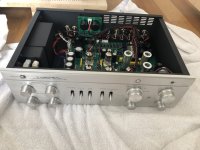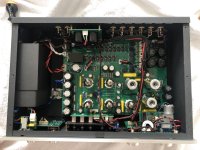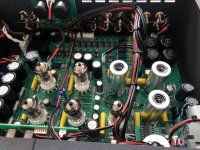Hello T.
thank you very much for your measurements.
Seems this circuit is still quite usable with today‘s high level sources 🙂
Regards Eberhard
thank you very much for your measurements.
Seems this circuit is still quite usable with today‘s high level sources 🙂
Regards Eberhard
Hello T.
thank you very much for your measurements.
Seems this circuit is still quite usable with today‘s high level sources 🙂
Regards Eberhard
You welcome @Zitronenfalter !
Yes of course : it is totally compliant with modern high level LINE sources.
It reaches 52VRMS output before clipping, so with a gain of circa 2 on the tone-corrector/buffer stage, it means that the acceptance in the CD/AUX. input is circa 26VRMS : way over than any today's high level sources - at least to my knowledge !
This evening, I could - despite the Sahara temperature we have here 😗 - listen more seriously to my SRPP ANZAÏ...
Turntable : TECHNICS SL-1200G with Audio-Technica AT-VM540ML cartridge.
Amplifier : McIntosh MC7100.
Speakers : my DIY 375L Vintage Studio Monitors.
Record - among others John Scofield, "Still Warm" album (Gramavison records / 1986).
My first impressions are :
- wide bandwith, from solid/deep bass to cristaline/crisps treble.
- well balanced tone, nothing subdued or in your face.
- high dynamics, notably heard on drums, but also on slap bass notes.
- sound finesse and detached musical details, no masking nor flooding.
Of course, all this must be validated by effective comparisons with other preamps...
T
Update : some data measured today on my finished and lastly refined/modded SRPP ANZAÏ :
Unfortunately I no more have distortion measurement facilities - and I plan to have one, when is the real question - but by my experience, looking at the triangle and sine waves, the max THD% should be around 1% at worse.
Just in regard of the max output level capability (and hence the dynamic margin) of the SRPP-ANZAÏ measured at 50VRMS, my ARC SP3A1 offers 25VRMS and my McIntosh C712 offers 8VRMS according to their respective specs - certainly with a lower THD%, I guess...
T
- RIAA equalization in the PHONO section is met at +/-1dB between 20Hz and 20kHz.
- PHONO input saturation @1kHz sinus is 130mVRMS for 50VRMS output.
- CD/AUX input saturation is 25VRMS for 50VRMS output.
- Bandwidth in CD/AUX section is 5Hz-45kHz@-1dB and 2.5Hz-85kHz@-3dB.
Unfortunately I no more have distortion measurement facilities - and I plan to have one, when is the real question - but by my experience, looking at the triangle and sine waves, the max THD% should be around 1% at worse.
Just in regard of the max output level capability (and hence the dynamic margin) of the SRPP-ANZAÏ measured at 50VRMS, my ARC SP3A1 offers 25VRMS and my McIntosh C712 offers 8VRMS according to their respective specs - certainly with a lower THD%, I guess...
T
Tubelectron do You know where could be found pcb board layout pictures - the copper side ?
No, unfortunately... A quick search did not revealed the circuit PCB as I have it (circa 1980), but possible modern equivalents...
https://www.diyaudio.com/community/threads/fs-anzai-srpp-tube-phono-preamp-and-output-buffer.361024/
T
Tubelectron thank You very much !
I will probably try to make my own lauyout.
Next thing that interests me are potentiometers used for tone controles - are they standard linear type, single gang or something else ?
+ the switch used for tone controles on / off, what type is is ?
Think this everything, thank You !
I will probably try to make my own lauyout.
Next thing that interests me are potentiometers used for tone controles - are they standard linear type, single gang or something else ?
+ the switch used for tone controles on / off, what type is is ?
Think this everything, thank You !
Hello krca45,
i too considered building this circuit, be it via point to point wiring or using perfboard.
When duplicating the separate tone controls for each channel you need single gang pots with "A" taper as declared in T.s schematic.
I must admid i rather had expected them to be "B" (=linear) taper though.
The tone defeat switch has to be a 4 pole double throw type (ON-ON) like this one -> APEM 5666
Alternatively one could use two dpdt switches which are more common. As a plus separate switches may improve channel separation and support keeping the wiring tidy.
Regards Eberhard
i too considered building this circuit, be it via point to point wiring or using perfboard.
When duplicating the separate tone controls for each channel you need single gang pots with "A" taper as declared in T.s schematic.
I must admid i rather had expected them to be "B" (=linear) taper though.
The tone defeat switch has to be a 4 pole double throw type (ON-ON) like this one -> APEM 5666
Alternatively one could use two dpdt switches which are more common. As a plus separate switches may improve channel separation and support keeping the wiring tidy.
Regards Eberhard
Thank you @krca45 and @Zitronenfalter !
First, if you are interested to built a SRPP ANZAÏ, there is a more evolved model, more "Audiophile" with even higher performances, but Phono only, no Tone-Correctors. Here's the link - sorry, it's all in French :
http://6bm8.lab.free.fr/Documentations/Revues/Audiophile/1977-1988/02/SRPP/SRPP.html
Other than this, the article concerning the SRPP ANZAÏ that I have is here - in French again - but there's a view of the PCB in the components side, at least :
http://6bm8.lab.free.fr/Documentations/Revues/Audiophile/1977-1988/07/SRPP/SRPP.html
Note that on this schematic, there is a mistake - that I fiercely reproduced without checking 🙄 - The RIAA networks shows two 82K resistors, but the one in series with the 47nF capacitor is a 6.2K - not a 82K ! :


So here's my updated corrected schematics :


Now to answer your questions - confirming @Zitronenfalter 's reading :
- The Tone-Control pots are A250K, that is to say LOG. On my SRPP they are separate (L and R), but you can indeed use a dual gang, if you prefer.
- The switch used for Tone-Control ON-OFF is a 4PDT switch, that is to say a double DPDT.
Here is the RIAA compliance table, measured on both channels :

And here is the overdload levels table :

Note that the 12AX7 tubes are not specially matched for these tests...
T
First, if you are interested to built a SRPP ANZAÏ, there is a more evolved model, more "Audiophile" with even higher performances, but Phono only, no Tone-Correctors. Here's the link - sorry, it's all in French :
http://6bm8.lab.free.fr/Documentations/Revues/Audiophile/1977-1988/02/SRPP/SRPP.html
Other than this, the article concerning the SRPP ANZAÏ that I have is here - in French again - but there's a view of the PCB in the components side, at least :
http://6bm8.lab.free.fr/Documentations/Revues/Audiophile/1977-1988/07/SRPP/SRPP.html
Note that on this schematic, there is a mistake - that I fiercely reproduced without checking 🙄 - The RIAA networks shows two 82K resistors, but the one in series with the 47nF capacitor is a 6.2K - not a 82K ! :
So here's my updated corrected schematics :
Now to answer your questions - confirming @Zitronenfalter 's reading :
- The Tone-Control pots are A250K, that is to say LOG. On my SRPP they are separate (L and R), but you can indeed use a dual gang, if you prefer.
- The switch used for Tone-Control ON-OFF is a 4PDT switch, that is to say a double DPDT.
Here is the RIAA compliance table, measured on both channels :
And here is the overdload levels table :
Note that the 12AX7 tubes are not specially matched for these tests...
T
Hello T.
thanks for all the efforts - i very much appreciate your precise and detailed documentation. 👍
🙂
Best Regards from near Cologne
Eberhard
thanks for all the efforts - i very much appreciate your precise and detailed documentation. 👍
🙂
Best Regards from near Cologne
Eberhard
Zitronenfalter & Tubelectron - Thank You very much.
Tubelectron - I have found article by Jean Hiraga but not the one by Anzai himself - big thanks for this one !
And the 6K2 resistor in RIAA EQ - much obliged.
French is not such a big problem - learned it at school, just need to remember much with good dictionary.
Anzai's version with tone controls interests me much more as whole preamp - the tone controls are actually useful to me, not often but enough to have curiosity to build it - in my basic setup i don't have them but i clearly hear the need for them, when using ordinary Luxman L2 integrated in hot summers.
The light + correction in the bass can bring a record to much greater satisfaction in listening, for example.
Will look at both articles in depth.
Thanks & regards, Krca
Tubelectron - I have found article by Jean Hiraga but not the one by Anzai himself - big thanks for this one !
And the 6K2 resistor in RIAA EQ - much obliged.
French is not such a big problem - learned it at school, just need to remember much with good dictionary.
Anzai's version with tone controls interests me much more as whole preamp - the tone controls are actually useful to me, not often but enough to have curiosity to build it - in my basic setup i don't have them but i clearly hear the need for them, when using ordinary Luxman L2 integrated in hot summers.
The light + correction in the bass can bring a record to much greater satisfaction in listening, for example.
Will look at both articles in depth.
Thanks & regards, Krca
Thank you Guys !
You will certainly appreciate the high level of dynamics that the SRPP ANZAÏ can bring... 😉
T
You will certainly appreciate the high level of dynamics that the SRPP ANZAÏ can bring... 😉
T
Interesting, those inside pictures remind me of my luxman preamplifier, it is also SRPP = cl38uc
I wonder did they have influence from Hiraga, what you tell me from sound seems similar from my luxman..
" For moving-magnet phono gain, the CL-38u uses three ECC83 dual-triode tubes in a shunt-regulated, push-pull (SRPP) configuration chosen to minimize the output impedance of each stage. Five ECC82 dual-triode tubes, also in SRPP configuration, provide line-level gain and the extra amplification required for the Luxman's tone controls"
I wonder did they have influence from Hiraga, what you tell me from sound seems similar from my luxman..
" For moving-magnet phono gain, the CL-38u uses three ECC83 dual-triode tubes in a shunt-regulated, push-pull (SRPP) configuration chosen to minimize the output impedance of each stage. Five ECC82 dual-triode tubes, also in SRPP configuration, provide line-level gain and the extra amplification required for the Luxman's tone controls"
Attachments
Yes, @matsurus : the LUXMAN CL38U is a nice modern SRPP preamp tube unit... Very costy also !

About my SRPP-ANZAÏ, I added some additional shielding in order to reduce the slight hum that superimpose to hiss at maximum volume on a 100WRMS ampfifier - absolutely not annoying but hey, why not try to eliminate it ?




Maybe a slight improvement, but rather no significant effect.
I shorted the phono input instead of connecting my turntable : no noticeable difference too.
Verdict : if you can build a separate power supply, it's better against hum...
T
About my SRPP-ANZAÏ, I added some additional shielding in order to reduce the slight hum that superimpose to hiss at maximum volume on a 100WRMS ampfifier - absolutely not annoying but hey, why not try to eliminate it ?
Maybe a slight improvement, but rather no significant effect.
I shorted the phono input instead of connecting my turntable : no noticeable difference too.
Verdict : if you can build a separate power supply, it's better against hum...
T
This is a very interesting thread. I‘m thinking of maybe try to build it point to point but without the tone controls. Would the 100k and 22k resistors between second ant third stage be needed then? What purpose do they have?
Great Tubelectro Project!
I'm going to do it for my 6v6 12ax7 pp amp.
Some questions. Why do the 12ax7 and 12AU7 go with 12V instead of 6.3V?
can I replace the 4H chocke with a 175ohm resistor??
thanx a lot for the info!!!!
I'm going to do it for my 6v6 12ax7 pp amp.
Some questions. Why do the 12ax7 and 12AU7 go with 12V instead of 6.3V?
can I replace the 4H chocke with a 175ohm resistor??
thanx a lot for the info!!!!
This is a very interesting thread. I‘m thinking of maybe try to build it point to point but without the tone controls. Would the 100k and 22k resistors between second ant third stage be needed then? What purpose do they have?
Thanks @Sykomor !
Easy : when the Tone-Control is defeated, the 100K + 22K attenuator divider has no other purpose than matching the attenuation of the Tone-Control circuit with all pots in neutral position. So the gain of the output stage is constant, T-C defeated or not : circa 2.
I did not measured the gain of the output stage alone, but I think that the 12AU7 probably provides a voltage gain of circa 10-15, which could be too high in regards of the signal levels standards of today...
If it is too much, then you would place the Volume pot instead of the T-C circuit, as a satisfactory solution. In this case, you would not need any of the parts of the T-C circuit, not the matching attenuator and switch. Otherwise, you let the Volume pot at the output, and preserve the 100K + 22K attenuator
I must confess that I did not made the test, as I wanted to preserve the T-C facility, sorry...
Great Tubelectro Project!
I'm going to do it for my 6v6 12ax7 pp amp.
Some questions. Why do the 12ax7 and 12AU7 go with 12V instead of 6.3V?
can I replace the 4H chocke with a 175ohm resistor??
thanx a lot for the info!!!!
Thanks @mrpunkk !
You can indeed heat the 12AX7 and 12AU7 in 6.3V, assuming you can provide 6.3VDC filtered. 6.3VAC would be too hummy for a preamp. It was just easier to obtain this from 12VAC for me, and it was the original design, that's all...
The original resistor that was in place of the 194A (175R/50mA/4H) choke was a 3K3/2W. If you remove the choke, return to this value, otherwise the filtering effect offered by a simple 175R resistor will not be enough. Note that you can use any other choke, say a 30H/500R or whatever you have on hand or can find locally. I used the 194A just because it is compact to place in the cabinet.
T
Manny thanks for your effort and prompt answer. Just curious: What do you intend to use the “OUTPUT” for?
Manny thanks for your effort and prompt answer. Just curious: What do you intend to use the “OUTPUT” for?
The OUTPUT is a direct signal out, in the case of a connection to an amp fitted with a volume control, or for recording... Possibly not very useful by now, it could be rewired to the Volume pots wipers, but since I have the AMP1/AMP2 switch (very useful in case of multiple amp ans speakers), I let it as is !
T
Hello T,
I don’t think you mentioned the change from 12AT7’s to 12AX7’s in the phono preamp section. What was the reason for which you made the change?
Is there any problem using 12AT7’s in your final circuit?
Thanks in advance.
Rick
I don’t think you mentioned the change from 12AT7’s to 12AX7’s in the phono preamp section. What was the reason for which you made the change?
Is there any problem using 12AT7’s in your final circuit?
Thanks in advance.
Rick
Hello T,
I don’t think you mentioned the change from 12AT7’s to 12AX7’s in the phono preamp section. What was the reason for which you made the change?
Is there any problem using 12AT7’s in your final circuit?
Thanks in advance.
Rick
Yes, you are right @Technical : I changed the 12AT7 for the 12AX7 in the RIAA section simply for a matter of global gain and noise level, to be similar to my other preamps.
The output stage is a 12AU7, because here I just need a bit of recovery gain to compensate the tone-control, and this tube offers a high input swing admittance. With the tones in neutral position, or tone off position, the gain of this stage is 2.
I must confess that did not field tested the 12AT7 and shifted directly to 12AX7, but I don't see reasons why it would not work : it's a matter of tests !
T
- Home
- Amplifiers
- Tubes / Valves
- SRPP ANZAÏ tube preamplifier


